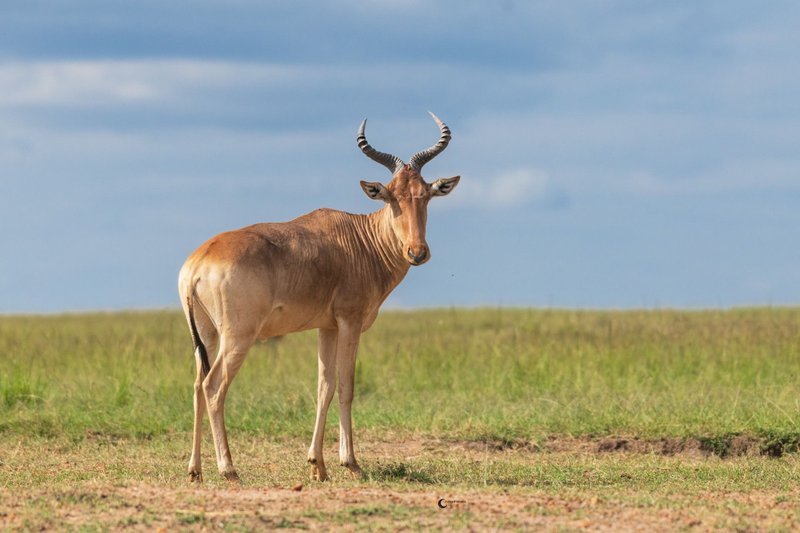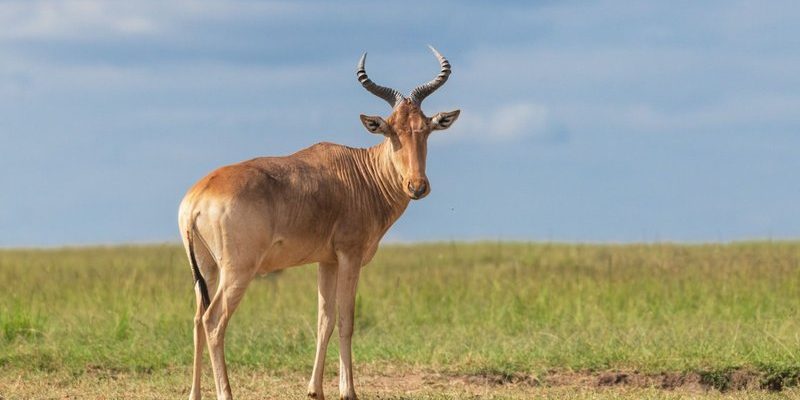
Hartebeests belong to the Bovidae family and are known for their remarkable adaptability. With their long, slender bodies and distinctive, elongated faces, they have an appearance that combines elegance with a touch of the bizarre. Think of them as nature’s quirky design, perfectly suited for their environment. Now, let’s explore ten captivating facts that shed light on their lives and the role they play in the ecosystem.
1. Unique Physical Characteristics
One of the first things you might notice about the hartebeest is its distinctive shape. They have a long face, elongated limbs, and a robust body that allows them to navigate their grassy habitats with ease. Their horns are another eye-catching feature. Males possess long, curved horns that can grow up to 30 inches long! These impressive antlers aren’t just for show; they play a vital role in combat during mating seasons.
Hartebeests also come in a few different species, including the topi and the Tsessebe. Each has its own subtle differences in coloration and size, but they all share that unique hartebeest charm. It’s as if Mother Nature wanted to create a creature that’s both functional and a little funky at the same time.
2. Habitat Preferences
Hartebeests are primarily found in the open savannas and grasslands of Africa, but they’re not picky about their surroundings. You might spot them in places ranging from woodlands to scrublands. They thrive in areas with abundant grass, perfect for their grazing diet.
These animals are surprisingly adaptable. Their long legs help them cover large distances in search of food and water. In fact, they can often be seen migrating in search of fresh grazing grounds. This ability to move helps prevent overgrazing and keeps the ecosystem balanced. You could say they’re like the ultimate nomads of the animal kingdom, always on the lookout for the next big meal!
3. Social Structure of Hartebeests
Hartebeests are social animals and generally live in groups. These herds can vary in size, often consisting of anywhere from a few individuals to a few dozen. The structure of these groups is fascinating; they’re usually led by a dominant male who protects his group from predators and rivals.
Within these herds, you’ll find a mix of males, females, and young ones. Females tend to be more social than males, often forming friendships and engaging in playful behavior. It’s kind of like a high school lunchroom where the girls stick together! This strong social structure helps them stay alert for threats, as there’s always someone on lookout duty.
4. Diet and Feeding Habits
Let’s talk about what makes a hartebeest tick—its diet! These animals are herbivores, primarily feeding on grasses and leaves. Their specialized digestive systems allow them to extract maximum nutrients from even the toughest of plants.
What’s interesting is their feeding strategy. Hartebeests often graze in the early morning or late afternoon when temperatures are cooler. This behavior not only helps them avoid the heat but also allows them to conserve energy. If you’ve ever tried to enjoy a meal outdoors on a hot day, you can understand why dining at dinner time makes sense!
5. Breeding and Reproduction
Hartebeests have a unique landscape when it comes to mating. During the breeding season, males establish territories and display their strength through physical confrontations. The winners get access to females while the losers are left to roam alone. It’s a competitive world out there!
After a gestation period of about seven months, females give birth to a single calf, which they hide in tall grass to protect from predators. It’s a risky strategy, but this concealment helps the calf avoid detection until it’s strong enough to keep up with the herd. Isn’t it fascinating how nature provides such clever solutions to survival?
6. Predators and Survival Strategies
Speaking of survival, hartebeests have to stay sharp. They face threats from various predators such as lions, hyenas, and crocodiles. Their long legs are more than just for show; they’re designed for speed. When they sense danger, these antelopes can run at impressive speeds of up to 50 km/h (31 mph)!
Beyond speed, hartebeests use their keen sense of sight and hearing to detect danger. Their large eyes give them excellent vision, helping them spot predators from a distance. It’s like having built-in radar! As a group, they communicate through alarm calls, alerting others to potential threats. Talk about teamwork!
7. Adaptations to Climate
Hartebeests have evolved to thrive in some of the harshest climates. They can tolerate high temperatures by using a unique ability to thermoregulate. Their long legs not only help them run but also keep their bodies cooler by increasing the distance between their bodies and the hot ground.
Additionally, they’re capable of surviving for days without water, relying on the moisture found in the grasses they consume. This trait makes them well-suited to the often dry and arid environments of Africa. It’s like they come with their own survival kit!
8. Conservation Status
Despite their fascinating qualities, hartebeests face challenges. Habitat loss and hunting have led to some species becoming endangered. Conservation efforts are in place to protect these unique animals and their habitats. Organizations are working to ensure that future generations can enjoy the sight of these remarkable creatures in their natural environment.
By creating protected areas and promoting sustainable practices, we can help maintain the delicate balance of the ecosystems where hartebeests thrive. Supporting wildlife conservation is crucial for preserving not just hartebeests but countless other species that share their habitats.
9. Cultural Significance
In various African cultures, hartebeests hold cultural significance. They are often depicted in art, folklore, and traditional stories. Their unique appearance and dynamic behavior inspire local artists and storytellers, allowing people to connect with nature and their heritage.
Additionally, hartebeests are sometimes used in local traditions and practices, showcasing their importance beyond just being another animal in the savanna. This connection to human culture highlights how intertwined our lives are with wildlife.
10. Fascination and Tourism
Finally, hartebeests are a delight for wildlife enthusiasts and tourists alike. Many people travel to Africa hoping to catch a glimpse of these remarkable creatures in their natural habitat. Tour companies often include them in safari itineraries, helping visitors appreciate their beauty and unique behaviors.
Seeing a hartebeest in the wild can be a breathtaking experience. It’s a reminder of the incredible biodiversity our planet holds. Whether you’re a casual observer or a dedicated conservationist, there’s something special about watching these creatures roam free, embodying the spirit of the African wilderness.
In summary, the hartebeest is much more than just an antelope. It’s a fascinating creature that plays an essential role in its ecosystem while captivating the minds of those who encounter it. By understanding and appreciating these animals, we can contribute to their preservation for future generations. So next time you think of Africa’s wildlife, remember the hartebeest and all the unique stories it has to tell!

